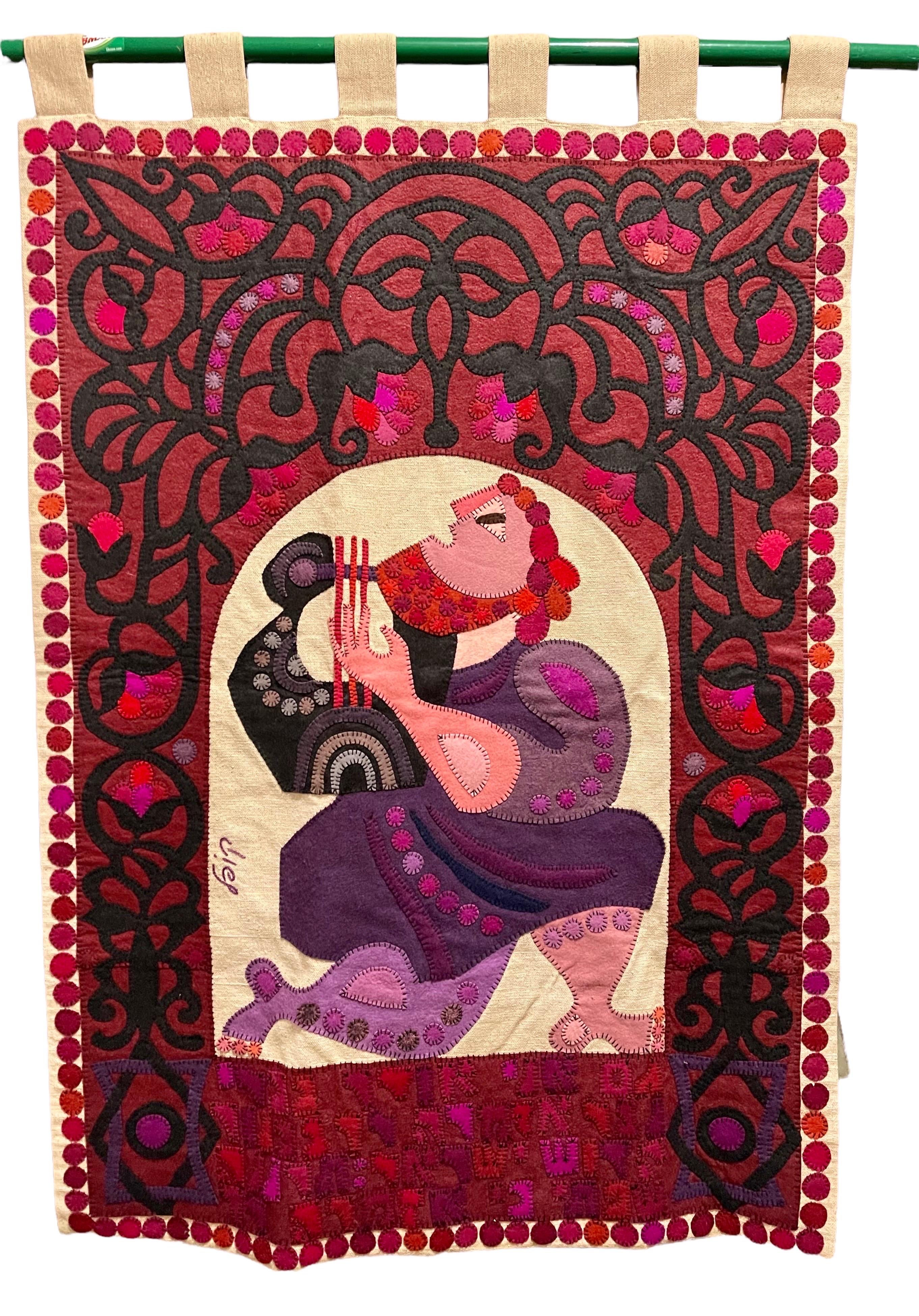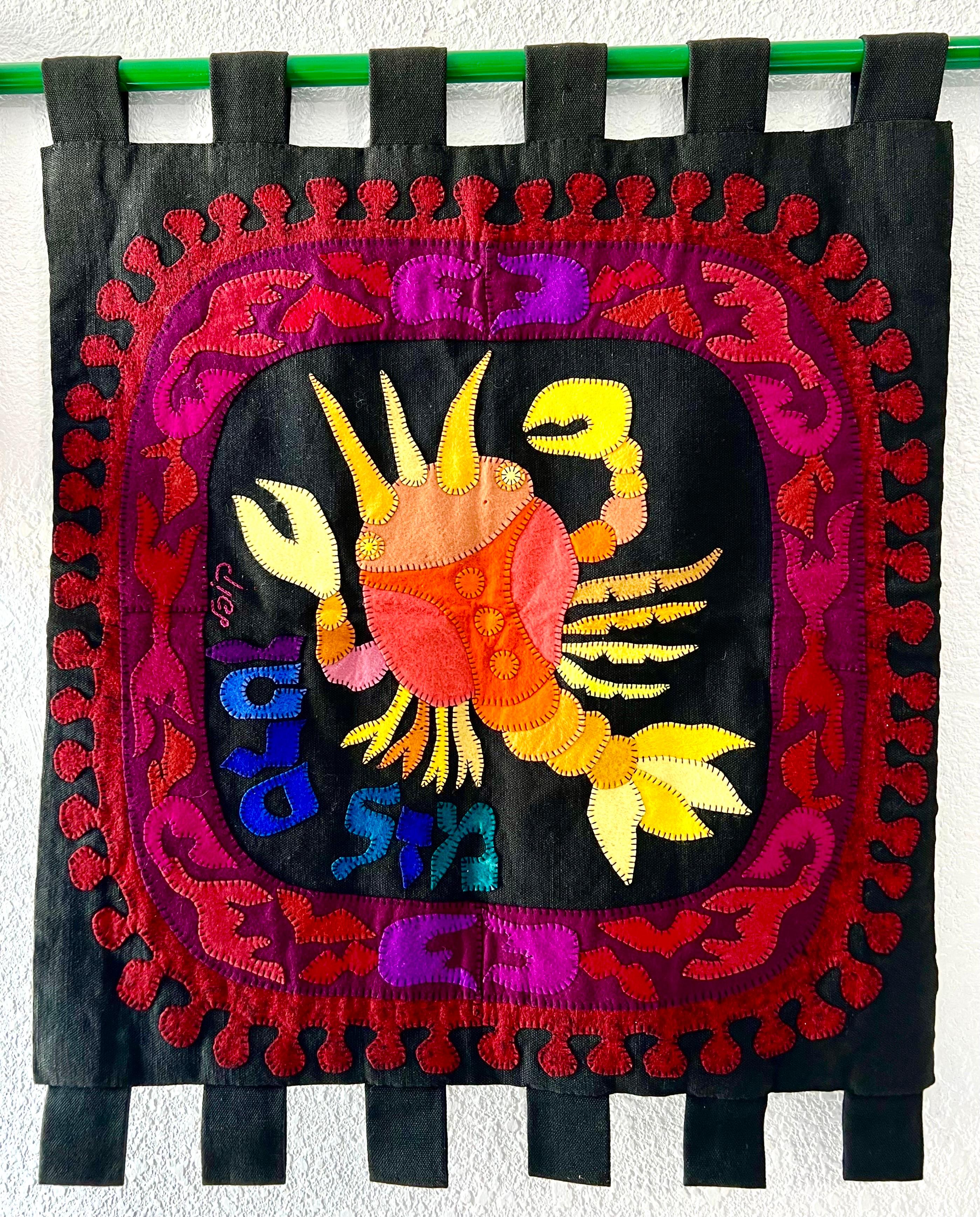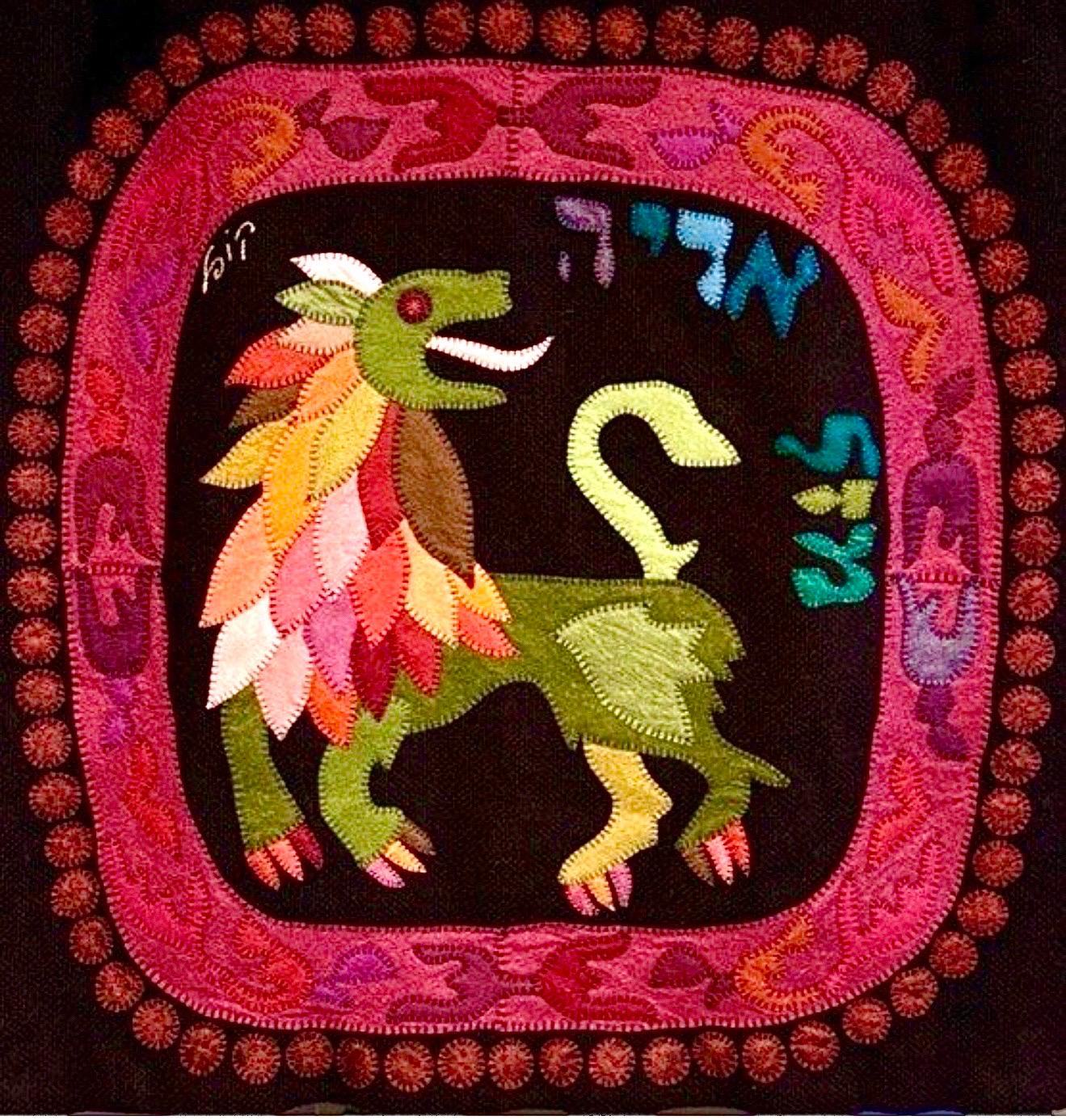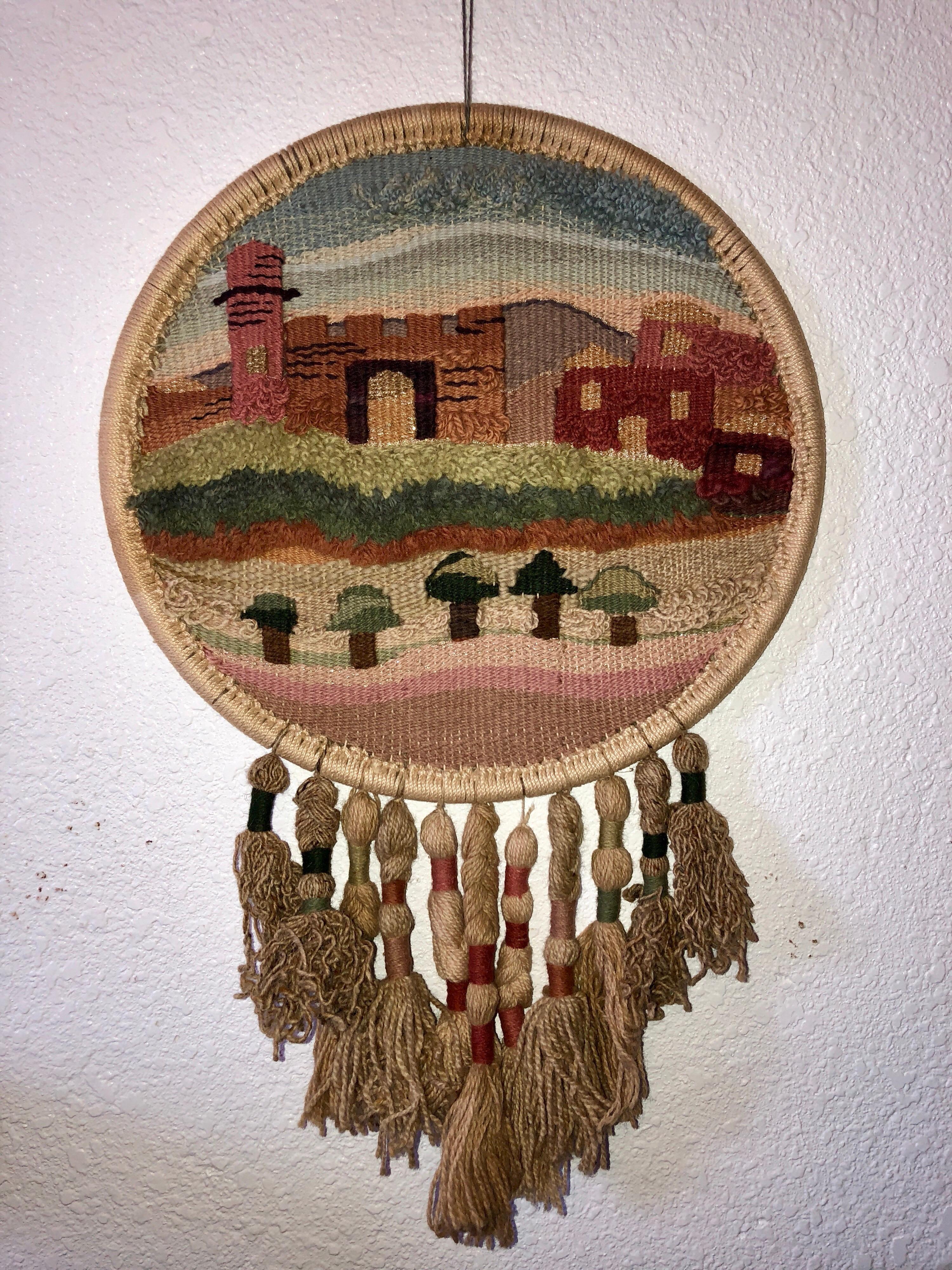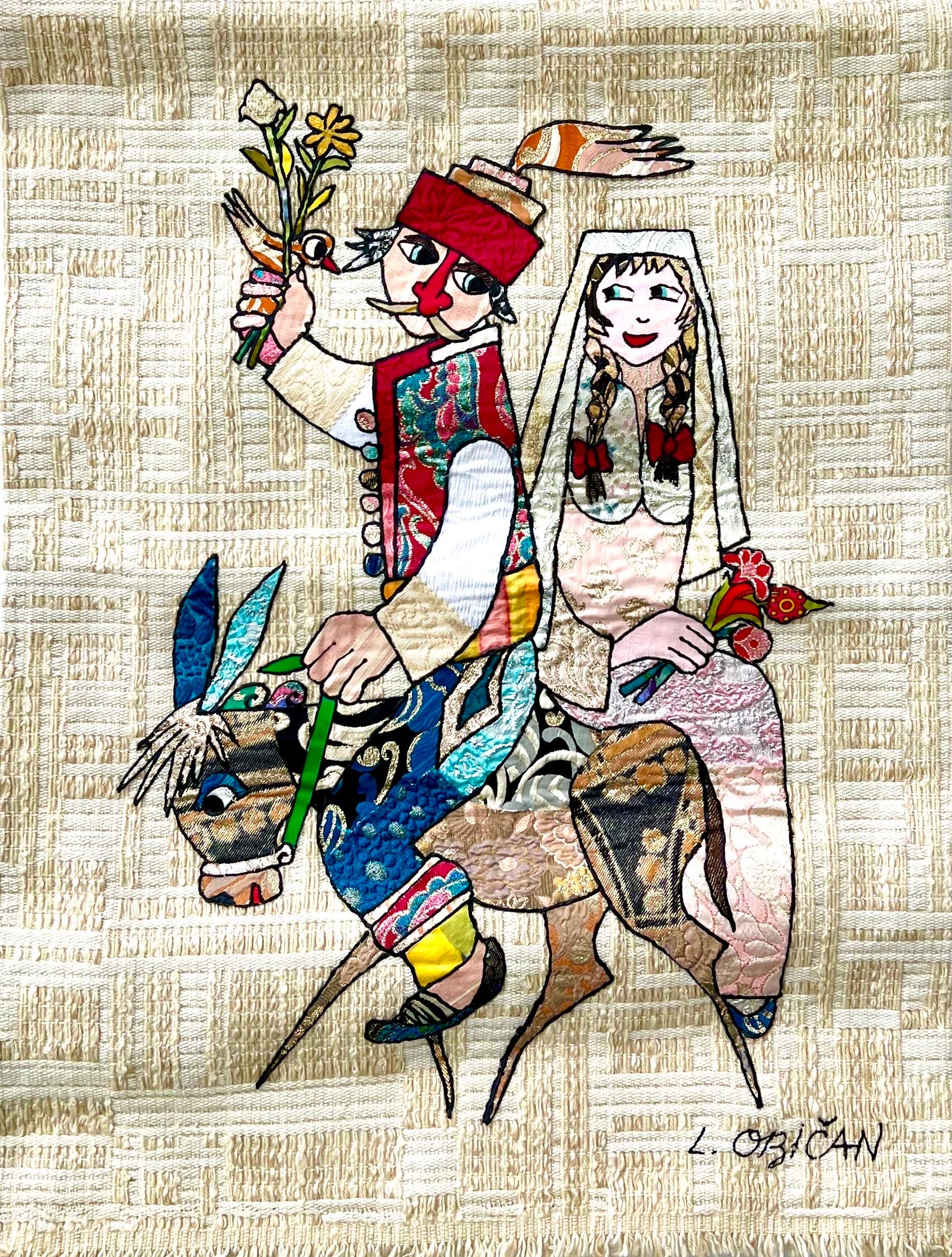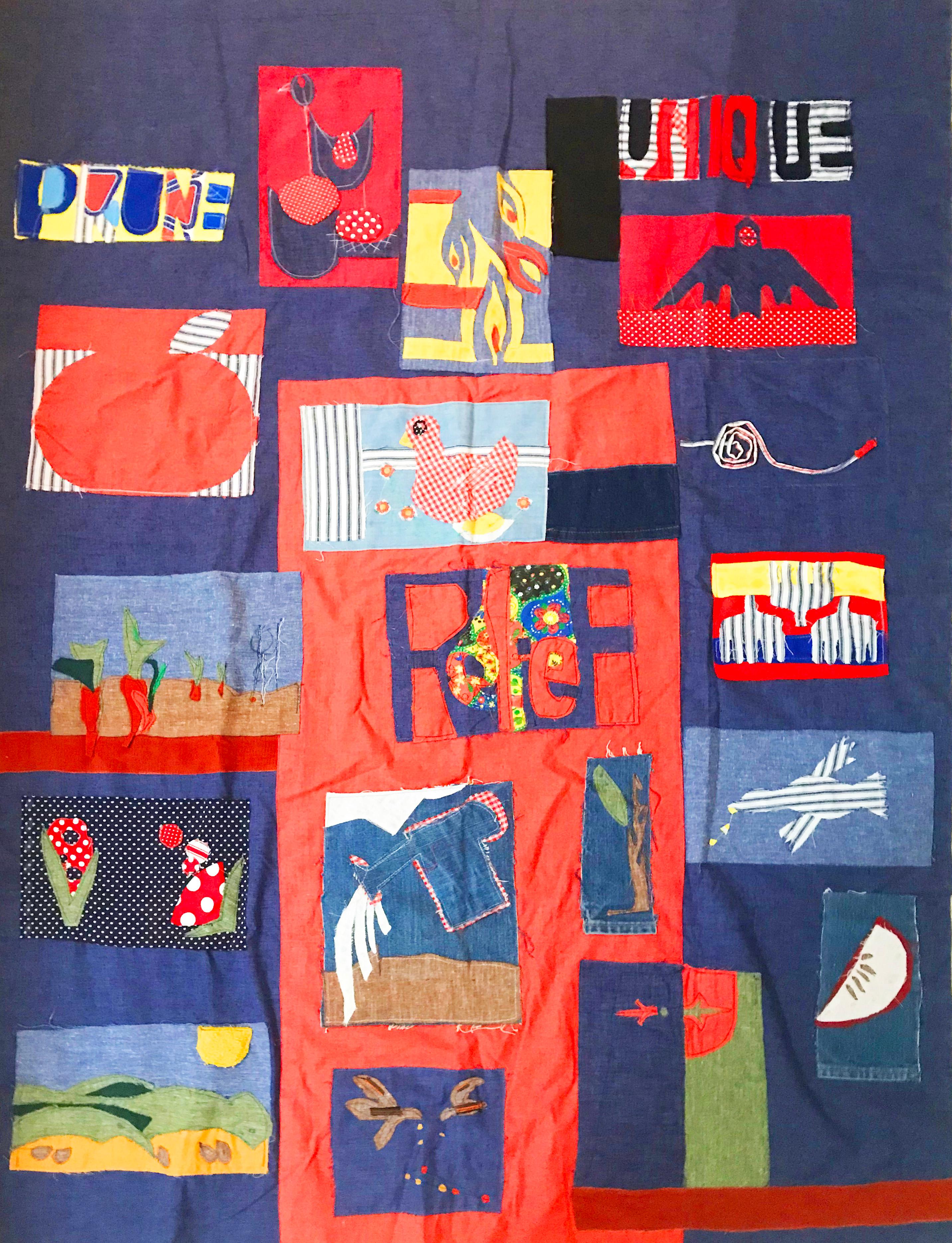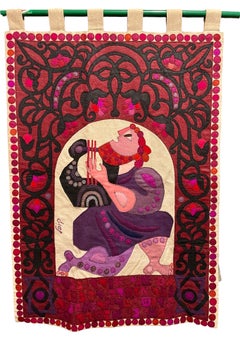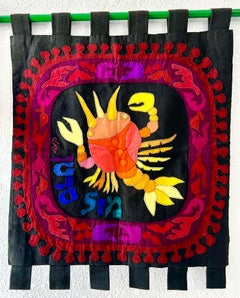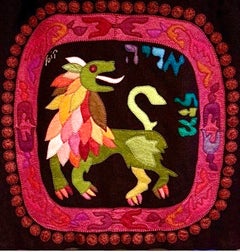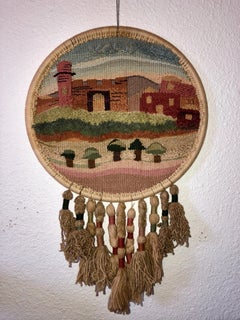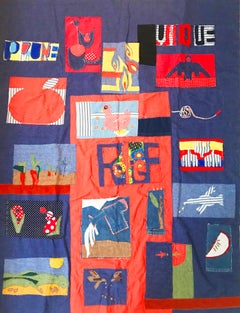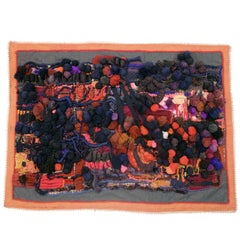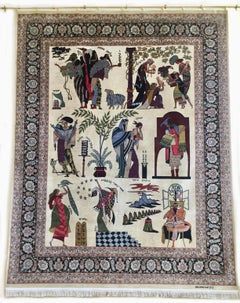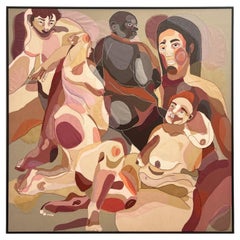Items Similar to Wool Felt Applique Israeli Folk Art Signed Tapestry Kopel Gurwin Bezalel School
Want more images or videos?
Request additional images or videos from the seller
1 of 12
Kopel GurwinWool Felt Applique Israeli Folk Art Signed Tapestry Kopel Gurwin Bezalel School
$3,200
£2,433.09
€2,802.95
CA$4,549.56
A$4,944.59
CHF 2,613.02
MX$59,818.84
NOK 32,543.32
SEK 30,739.19
DKK 20,927.19
About the Item
This depicts KIng David reciting Psalms, Hallelujah in Hebrew
Kopel Gurwin (Hebrew: קופל גורבין) (1923–1990) was an Israeli tapestry wall hanging, painter and graphic artist.
Kopel (Kopke') Gurwin (Gurwitz) was born and raised in Vilna, the capital of Lithuania. He spoke Yiddish at home, but simultaneously studied Hebrew at their school which was part of the Tarbut educational network. Kopel was active in the Hashomer Hatzair youth movement. In the 1930s, as a teenager, Kopel helped his parents with the home finances by working in a suit workshop, there he first encountered the art of sewing.
With the outbreak of the Second World War and the German invasion of Vilna, the Jews were imprisoned in camps and ghettos. Kopel and his brother Moshe were separated from their parents and were put to work in coal mines and peat. Kopel's parents were taken to the Stutthof Nazi concentration camp where they died of typhus within a month of each other. Kopel's 12-year-old sister Chava was turned over to the Germans by a Polish family and murdered.
The brothers were arrested by the Germans, but were saved thanks to the connections of Nina Gerstein, Kopel's drama teacher. They hid in an attic until they were discovered, fled and moved to Riga, where they were caught and sent to the Stutthof concentration camp where they were imprisoned until the end of the war. They were put to work maintaining and cleaning trains and took part in one of the death marches. In July 1946, Kopel and Moshe sailed to Helsingborg, Sweden, as part of operation "Folke Bernadotte", in which Sweden took in ill survivors for rehabilitation. Once he recovered, Kopel worked in a publishing house and later was appointed director of the local branch of the Halutz movement.
In 1950 Kopel and Moshe made aliyah to Israel. Kopel worked as a survey for the Survey of Israel Company. In 1951, he enlisted to the Communication Corps and served as a military draftsman. There he won first prize for the design of the front cover of the Communication Corps bulletin.
With his discharge from the army at 29 he started studying drawing and graphics at the Bezalel Academy of Arts and Design in Jerusalem. Among his teachers were Isidor Ascheim, Shlomo Vitkin, Yossi Stern and Jacob Steinhardt. At the end of his first year of study, Kopel won the Reuben and Sarah Lif Excellence Award in written studies. During his studies he also won additional prizes: In 1956 he won first prize from the Lethem Foundation in California for poster design. Later the same year, Kopel won the Hermann Struck prize for his drawing on the theme of Jerusalem.
In 1957 he won an additional first prize from the Lethem Foundation and second place from the printing company Ortzel for a drawing for a Jewish New Year greeting card. In 1958 he won first prize in a competition to design a poster for Tel Aviv's jubilee.
Two years later he won three other awards: First and third prize for designing a poster for Israel Independence Day, celebrating 12 years of the State of Israel.
Also that year Kopel won first prize for a poster to mark the 25th Zionist Congress.
In 1964 he entered the Independence Day poster competition on the theme of aliyah and won first and second prize. Four years later he again entered the competition on the theme of 20 years of Israel's independence and won first prize. The poster was styled like a Holy Ark curtain with two lions and a menorah at its centre. This poster appeared on the cover of the famous book Jewish Art and Civilization, edited by Geoffrey Wigoder as well as the record Voices of 20 Years, 1948-1968, edited by Yossi Godard. In April 1971 he won first prize in the Independence Day poster competition for the fourth time.
Kopel's Folk Art tapestry won the Israeli Independence Day Poster Contest in 1968
With the completion of his studies at Bezalel Kopel moved to Tel Aviv and was hired by Shmuel Grundman's graphics and design studio. Grundman took him to Europe with him to design and supervise the construction of Israeli exhibition pavilions. During his time at Grundman's he discovered the fibrous felt from which he produced most of his wall hangings. At the 1964 Levant Fair exhibition he used felt stuck onto wooden panels for the first time.
The first felt wall hanging that Kopel produced was intended for the American Cultural Centre in Jerusalem and its theme was the United States Declaration of Independence. The wall hanging, which measured 2.85 X 1.85 meters, was stuck on a wooden panel. Kopel ordered rolls of felt from France and began work on wall hangings based on bible stories. He used a needle, hand sewing small even stitches with black embroidery thread which framed and highlighted every detail in the work, as well as using appliqué. The interior designer, Alufa Koljer-Elem, introduced him to Ruth Dayan who managed the shop Maskit in September 1967 he opened his first solo exhibition at the Maskit 6 gallery, in which 12 wall hangings were displayed.
In light of the exhibition at Maskit 6, Meira Gera, the director of artistic activity at the America-Israel Cultural Foundation, organized an additional exhibition of his works at the foundation's exhibition hall in New York City. The exhibition sparked immense press interest, and was also displayed for a few months at the New York Jewish Museum, from where it travelled throughout the United States.
Followed by the exhibition at the Delson-Richter gallery in Old Jaffa, which was later also exhibited at the Jerusalem Theatre.
Kopel's tapestry "The Time for Singing has Arrived" was printed on a UNICEF greeting card in 1978 and again in 1981.
The Israeli Philatelic Service issued three stamps based on three of Kopel's holy ark curtains and one stamp based on an Independence Day poster he designed.
Kopel's creations decorate a large number of synagogues, public buildings, hotels and private collections which were purchased in Israel and around the world. They have decorated, among others, the walls of the King David Hotel in Jerusalem, the VIP room at Ben Gurion Airport, the Kfar Saba theatre and the Plaza Hotel in Tel Aviv.
Israel has had a Vibrant Folk Art, Naive art scene for a long time now artists like Israel Paldi, Nahum Guttman, Reuven Rubin had naive periods. The most well know of the strict naive artists are Shalom of Safed, David Sharir, Irene Awret, Gabriel Cohen, Natan Heber, Michael Falk and Kopel Gurwin.
Exhibitions:
1995 The Knesset Jerusalem
1988 Temple Beth Shalom Miami, Florida
1988 University of Jewish Studies Los Angeles
1987 Israel Congregation on the Northern Coast Chicago
1985 Jerusalem Theatre Jerusalem
1984 Tenafly New Jersey
1983 Horace Richter Gallery Old Jaffa
1974 Jerusalem Theatre Jerusalem
1974 Delson Richter Gallery Old Jaffa
1972 University of Jewish Studies Miami, Florida
1971 Jewish Museum New York
1970 Norman Gallery Canada
1970 Sharei Tzedek Congregation Winnipeg, Canada
1970 Gallery of the Year Los Angeles
1970 Gallery of the Year Scottsdale
1969 Gleeman Gallery Chicago
1969 Israel Congregation of the Northern Coast Chicago
1967 Maskit 6 Tel Aviv
Prizes:
1971 First Independence Day poster 1971, 23 yeaes of the State of Israel
1969 Second International Tel Aviv poster fair
1968 First Independence Day poster 1968, 20 years of the State of Israel
1964 First and Second Independence Day poster 1964,
1960 First Poster for the 25th Zionist Congress
1960 First and Third Independence Day poster 1960, 12 years of the State of Israel
1958 First Poster for the Tel Aviv jubilee
1957 Prize from the printing company Ortzel for a Jewish New Year greeting card
1957 First Foundation in California for poster design
1957 Herman Struck award for a drawing on the subject of Jerusalem
1956 First Prize from the Lethem Foundation in California for poster design
1954 Distinction Reuben and Sarah Lif award for distinction in calligraphy
1951 Front cover design for IDF Army Communication Corps bulletin
- Creator:Kopel Gurwin (1923 - 1990, Israeli, Lithuanian)
- Dimensions:Height: 40 in (101.6 cm)Width: 29 in (73.66 cm)
- Medium:
- Movement & Style:
- Period:
- Condition:minor toning commensurate with age and use.
- Gallery Location:Surfside, FL
- Reference Number:1stDibs: LU38214095952
About the Seller
4.9
Platinum Seller
Premium sellers with a 4.7+ rating and 24-hour response times
Established in 1995
1stDibs seller since 2014
1,815 sales on 1stDibs
Typical response time: 1 hour
- ShippingRetrieving quote...Shipping from: Surfside, FL
- Return Policy
Authenticity Guarantee
In the unlikely event there’s an issue with an item’s authenticity, contact us within 1 year for a full refund. DetailsMoney-Back Guarantee
If your item is not as described, is damaged in transit, or does not arrive, contact us within 7 days for a full refund. Details24-Hour Cancellation
You have a 24-hour grace period in which to reconsider your purchase, with no questions asked.Vetted Professional Sellers
Our world-class sellers must adhere to strict standards for service and quality, maintaining the integrity of our listings.Price-Match Guarantee
If you find that a seller listed the same item for a lower price elsewhere, we’ll match it.Trusted Global Delivery
Our best-in-class carrier network provides specialized shipping options worldwide, including custom delivery.More From This Seller
View AllWool Felt Craft Applique Vintage Israeli Judaica Folk Art Tapestry Kopel Gurwin
By Kopel Gurwin
Located in Surfside, FL
This depicts King David playing the harp, along with a verse in Hebrew from the Psalms. all made by hand. woven and stitched. Vintage, original piece.
Kopel Gurwin (Hebrew: קופל גור...
Category
20th Century Folk Art Mixed Media
Materials
Wool, Felt
Wool Felt Applique Israeli Folk Art Signed Tapestry Kopel Gurwin Bezalel School
By Kopel Gurwin
Located in Surfside, FL
This depicts a Crab, In Hebrew Mazel Sartan (the Zodiac symbol Cancer, June-July) all made by hand. woven and stitched.
Kopel Gurwin (Hebrew: קופל גורבין) (1923–1990) was an Israeli tapestry wall hanging, painter and graphic artist.
Kopel (Kopke') Gurwin (Gurwitz) was born and raised in Vilna, the capital of Lithuania. He spoke Yiddish at home, but simultaneously studied Hebrew at their school which was part of the Tarbut educational network. Kopel was active in the Hashomer Hatzair youth movement. In the 1930s, as a teenager, Kopel helped his parents with the home finances by working in a suit workshop, there he first encountered the art of sewing.
With the outbreak of the Second World War and the German invasion of Vilna, the Jews were imprisoned in camps and ghettos. Kopel and his brother Moshe were separated from their parents and were put to work in coal mines and peat. Kopel's parents were taken to the Stutthof Nazi concentration camp where they died of typhus within a month of each other. Kopel's 12-year-old sister Chava was turned over to the Germans by a Polish family and murdered.
The brothers were arrested by the Germans, but were saved thanks to the connections of Nina Gerstein, Kopel's drama teacher. They hid in an attic until they were discovered, fled and moved to Riga, where they were caught and sent to the Stutthof concentration camp where they were imprisoned until the end of the war. They were put to work maintaining and cleaning trains and took part in one of the death marches. In July 1946, Kopel and Moshe sailed to Helsingborg, Sweden, as part of operation "Folke Bernadotte", in which Sweden took in ill survivors for rehabilitation. Once he recovered, Kopel worked in a publishing house and later was appointed director of the local branch of the Halutz movement.
In 1950 Kopel and Moshe made aliyah to Israel. Kopel worked as a survey for the Survey of Israel Company. In 1951, he enlisted to the Communication Corps and served as a military draftsman. There he won first prize for the design of the front cover of the Communication Corps bulletin.
With his discharge from the army at 29 he started studying drawing and graphics at the Bezalel Academy of Arts and Design in Jerusalem. Among his teachers were Isidor Ascheim, Shlomo Vitkin, Yossi Stern and Jacob Steinhardt. At the end of his first year of study, Kopel won the Reuben and Sarah Lif Excellence Award in written studies. During his studies he also won additional prizes: In 1956 he won first prize from the Lethem Foundation in California for poster design. Later the same year, Kopel won the Hermann Struck prize for his drawing on the theme of Jerusalem.
In 1957 he won an additional first prize from the Lethem Foundation and second place from the printing company Ortzel for a drawing for a Jewish New Year greeting card. In 1958 he won first prize in a competition to design a poster for Tel Aviv's jubilee.
Two years later he won three other awards: First and third prize for designing a poster for Israel Independence Day, celebrating 12 years of the State of Israel.
Also that year Kopel won first prize for a poster to mark the 25th Zionist Congress.
In 1964 he entered the Independence Day poster competition on the theme of aliyah and won first and second prize. Four years later he again entered the competition on the theme of 20 years of Israel's independence and won first prize. The poster was styled like a Holy Ark curtain with two lions and a menorah at its centre. This poster appeared on the cover of the famous book Jewish Art and Civilization, edited by Geoffrey Wigoder as well as the record Voices of 20 Years, 1948-1968, edited by Yossi Godard. In April 1971 he won first prize in the Independence Day poster competition for the fourth time.
Kopel's Folk Art tapestry won the Israeli Independence Day Poster Contest in 1968
With the completion of his studies at Bezalel Kopel moved to Tel Aviv and was hired by Shmuel Grundman's graphics and design studio. Grundman took him to Europe with him to design and supervise the construction of Israeli exhibition pavilions. During his time at Grundman's he discovered the fibrous felt from which he produced most of his wall hangings. At the 1964 Levant Fair exhibition he used felt stuck onto wooden panels for the first time.
The first felt wall hanging that Kopel produced was intended for the American Cultural Centre in Jerusalem and its theme was the United States Declaration of Independence. The wall hanging, which measured 2.85 X 1.85 meters, was stuck on a wooden panel. Kopel ordered rolls of felt from France and began work on wall hangings based on bible stories. He used a needle, hand sewing small even stitches with black embroidery thread which framed and highlighted every detail in the work, as well as using appliqué. The interior designer, Alufa Koljer-Elem, introduced him to Ruth Dayan who managed the shop Maskit in September 1967 he opened his first solo exhibition at the Maskit 6 gallery, in which 12 wall hangings were displayed.
In light of the exhibition at Maskit 6, Meira Gera, the director of artistic activity at the America-Israel Cultural Foundation, organized an additional exhibition of his works at the foundation's exhibition hall in New York City. The exhibition sparked immense press interest, and was also displayed for a few months at the New York Jewish Museum, from where it travelled throughout the United States.
Followed by the exhibition at the Delson-Richter gallery in Old Jaffa, which was later also exhibited at the Jerusalem Theatre.
Kopel's tapestry "The Time for Singing has Arrived" was printed on a UNICEF greeting card in 1978 and again in 1981.
The Israeli Philatelic Service issued three stamps based on three of Kopel's holy ark curtains and one stamp based on an Independence Day poster he designed.
Kopel's creations decorate a large number of synagogues, public buildings, hotels and private collections which were purchased in Israel and around the world. They have decorated, among others, the walls of the King David...
Category
20th Century Folk Art Mixed Media
Materials
Wool, Felt
Wool Felt Applique Israeli Folk Art Lion Signed Tapestry Kopel Gurwin Bezalel
By Kopel Gurwin
Located in Surfside, FL
This tapestry depicts a Lion, In Hebrew Mazel Aryeh (the Zodiac symbol Leo,) all handmade. woven and stitched.
Kopel Gurwin (Hebrew: קופל גורבין) (1923–1990) was an Israeli tapest...
Category
20th Century Folk Art Mixed Media
Materials
Wool, Felt
Jerusalem Wall Hanging Hand Embroidered tapestry Israeli Craft Judaica Folk Art
By Esther BenSimon
Located in Surfside, FL
This is an artistic weaving depicting the old city of Jerusalem. Signed in Hebrew and dated verso. it is all Hand Woven.
Esther Bensimon is a native of Argentina. She graduated from the Teacher’s College of Yeshiva University in New York City and immigrated to Israel in 1968. She is held in high regard as both an artist and a human being. Perpetually fascinated by the world of art, Esther Bensimon originally fulfilled her yearning to become a part of it by weaving magnificent wall hangings. She was accepted, early in her career, as a member of The House of Quality, the prestigious Jerusalem artist cooperative where she opened her first studio. It is a prestigious venue with sculpture by David Palombo and artists studios Zelig Segal, Ori Resheff, Avi Biran, Menachem Berman...
Category
1980s Folk Art Mixed Media
Materials
Wool, Cotton
Naive European French Folk Art Jovan Lazar Obican Tapestry Wall Hanging Weaving
Located in Surfside, FL
Lazar Obican 1944-2004
Tapestry, mixed media applique on woven background
Taking The Bird Away, Folk Art,
Dimensions: H 80 cm (32.25 in.) x W 58 cm (23in.)
The artist Lazar Obican iconic style is child-like yet masterfully adult; a style that tells a story with sociological overtones. His funny little people are always colorful, full of spirit, living with music and birds to bring them happiness. This is not an aubusson style but a pieced applique, quilt like style on a wool woven background. Mid century modern textile art...
Category
Mid-20th Century Folk Art Figurative Paintings
Materials
Canvas, Oil
Vintage Handwoven Tapestry Wool Folk Art Rug Weaving Wall Hanging Olga Fisch
By Olga Fisch
Located in Surfside, FL
Olga Fisch ( American 1901-1990)
Hummingbird and Pendant Flower, hand woven and stitched wool and sequins, signed lower right.
Dimensions: 58 x 32 in.
Olga Fisch was born in Hungary, studied in Germany and lived in Morocco and Ethiopia before receiving asylum as a Jewish refugee in Ecuador in 1939. For her Indian-inspired designs, Mrs. Fisch uses natural black and white sheep...
Category
20th Century Folk Art More Art
Materials
Wool
You May Also Like
"Unique" Folk Art Style Hand Made Tapestry
By Bill Condon
Located in Houston, TX
Tapestry of a collection of brightly color abstract scenes titled "Unique" by Bill Condon. The piece is made out of various fabric pieces stitched onto light denim fabric.
Artist Bi...
Category
20th Century Folk Art Mixed Media
Materials
Tapestry
Art Work Tapestry Signed M.J Guevel, France, 1970
Located in Paris, FR
Impressive art work tapestry. Unique sculptural combination of free-form in wool fiber, knitted and wowen elements and pieces of various fabric sewn on a ancient rug...
Category
Vintage 1970s French Tapestries
Who Knows One (Passover), Large Tapestry Rug by Shlomo Katz
By Shlomo Katz
Located in Long Island City, NY
Artist: after Shlomo Katz, Polish/Israeli (1937 - 1992)
Title: Who Knows One (Passover)
Year: 2000
Medium: Woolen Carpet Tapestry, signature in the cache
Size: 120 x 95 in. (304.8 x ...
Category
Early 2000s Expressionist More Art
Materials
Tapestry, Wool
Acrylic, Wool and Cotton Embroidery and Patchwork on Canvas by Ela Fidalgo
Located in Ibiza, Spain
De Ente Et Essentia VI, 2022, Ela Fidalgo
Acrylic, wool and cotton embroidery and patchwork on canvas.
Ela Fidalgo has developed her technique using embroidery, acrylic, fabrics, o...
Category
2010s Spanish Tapestries
Materials
Wool, Cotton, Acrylic
French artistic wall tapestry signed and dated 1977
Located in L’ISLE-SUR-LA-SORGUE, FR
French wall tapestry from 1977, hand-woven by the artist using a variety of materials such as jute, cotton and wool.
An artistry showcasing a stunning blend of shades and textures.
...
Category
Vintage 1970s French Mid-Century Modern Tapestries
Materials
Wool, Jute, Cotton
Cru si fiction Barbara d'Antuono 21st Century Contemporary outsider textile art
Located in Paris, FR
Embroidered textile painting
Unique work
Penelope or Parque of modern times, Barbara d’Antuono sews by hand like others recite mantras and decides nothing in advance. She lets images arise without any particular coherence with each other, but to which she gives substance in a kind of urgency, in the form of a strip not drawn but sewn. The exhibition, like the eponymous book, covers seven years of this assiduous and patient work through nearly 30 textile works, real freeze frames made of the emotions and memories of the artist, like so many portraits of humanity. . Her meeting in Haiti with Baron...
Category
2010s Contemporary Mixed Media
Materials
Textile
More Ways To Browse
Bezalel Art
Plaza Hotel
Vintage French Wall Tapestry Hanging Tapestries
Shalom Vintage
Signed Wool Tapestry
King David
Folk Art Lion
Declaration Of Independence
Temple Jerusalem
Shalom Of Safed
Applique Tapestry
California Poster
Vintage California Posters
Poster Israel
Yossi Stern
Lion Tapestry
Lion Menorah
Rajan Seth
